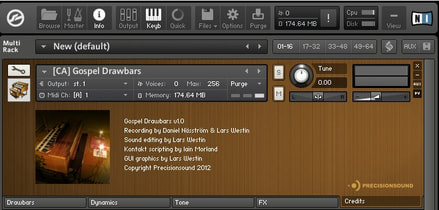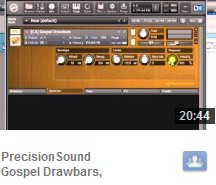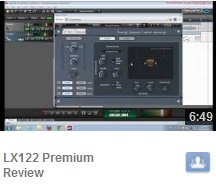PrecisionSound Gospel Drawbars Review
There have been a few notable Hammond organ sample libraries and VIs (Virtual Instruments) released over the past 10 years. Some of these made us sit up and keenly take notice, whilst others were greeted with yawns of disinterest. I’m excited to present this latest offering from Sweden’s masters of sampling, PrecisionSound – the amazing “Gospel Drawbars”. This ear-tickling sample-set is available in both NI Kontakt and Logic EXS24 formats.
PrecisionSound have been outputting respectable sample sets, in various formats, since 2003 and with each new release, it is obvious that they are honing and refining their sampling processes. When I first loaded this 1 GB sample set into Kontakt 5, I knew immediately that it wasn’t yet another ‘so so’ virtual Hammond wannabe. The depth and richness of ‘believable’ tonewheel sound must be experienced to be understood.
Gospel Drawbars is NOT another B3 sample library; this one is a meticulously-recorded 24 bit/44.1khz digital sample-set of a rare, well-functioning Hammond AB organ (circa 1937). The AB was Hammond’s 2nd offering, and is the direct ancestor of the B3/C3 line. This sample-set is absolutely soaking wet with vibe, character, and vintage-sounding charm. It’s almost too good to be true; the most unique Hammond organ sounds to have ever been heard “in the box” for only $69. By the way, a full-length video presentation accompanies this review. (Pssst, it's near the bottom of the page.)
Installation and Authorization:
First off, providing you already own a copy of Kontakt 3, 4 or 5, you’ve already undergone all the “authorizing” required. Gospel Drawbars is a sample-set, not a formal sample library. This sample-set is comprised of over 950 stereo wav files which PrecisionSound have recorded in 24 bit/44.1khz. A total of 22 different drawbar settings are prepackaged as typical .nki files. These settings are easily loaded into Kontakt with the included .nki files. Once you’ve purchased the product, a link to the downloadable zip file will be emailed to you. The email will also disclose the necessary zip file encryption password, in effect providing you with an “unlocking” code. Within the zip file is yet another archived file; this time it being in RAR format and without requiring a password. ** Please Note: This is NOT a Kontakt Library. It is a Kontakt sample-set and as such, requires the FULL version of Kontakt. It can be used in the free Kontakt player, but like all non-licensed sample-sets, it will only be accessible in DEMO mode only and as such will time out after 15 minutes (Kontakt Player 5) or after 30 minutes (Kontakt Player 3/4).
Visuals:
Gospel Drawbars provides the user with a good degree of control over the sound and behaviour of the instrument via four tabs: Drawbars, Dynamics, Tone, and FX. The medium brown motif has a decidedly “wooden” appearance in keeping with the color and materials observed on the physical instrument. The various knobs respond smoothly to mouse movements with finer settings made by “Shift-click/drag” mousing. To reset any control to its default position is a simple matter of ctrl + click. [Drawbars] This panel hosts two modes of operation: “Stack” or “Split”. The former combines both sets of drawbars while Split mode forces each region of your keyboard to use individual drawbar settings. Generally speaking, I personally feel that the “Stack” mode is most usable. This is mainly due to the fact that the predefined drawbar settings are a little too restrictive and only make use of two, three or four drawbars per slot. Speaking of slots, each of the organs manuals (upper/lower keyboards) is assigned a “slot”. Each slot has independent volume and tuning controls. There are 10 drawbar settings per slot, as well as an option to mix in bass pedal sounds. While the sample-set is operating in split mode, the split point is adjustable up to C5. The 2nd slot can be configured to use sounds one or two octaves lower if the sound is too shrill. This adds up to a nice degree of control, and it is certainly possible to achieve a pleasant “chords” sound with the left hand, and good melody tones with the right hand. If the octave range isn’t lowered on slot 2, the upper notes tend to be too shrill for most applications. The bass pedals are hard-mapped to the lowest octave range of a keyboard – C0 to B1. [Dynamics] The Dynamics tab provides basic envelope-shaping control with “Attack” and “Decay” knobs. At their default settings, this instrument has a pleasant, well-defined percussive quality. Of course, it can be mellowed out completely with increased Attack and Decay times. The “Release” levels knob lets the user dial in the amount of key off/release sound to taste. The default value of -12 dB is a wee bit strong for my own taste so I tend to lower the release levels by another 3 or 4 dB. The “Bass Mix” knob blends the ratio of Pedal 16 and MixturPedal with a range of -/+ 12 dB. Set fully counter-clockwise (-12 dB) lets only the Pedal 16 tones to be heard, while turning the knob fully clockwise (+12 dB) results in MixturPedal alone. The default, center detent, is an equal blend of both. The “Response” knob sets the relationship of how the instrument responds to keyboard velocity. While this knob is set to 0 percent, the behaviour of the organ is unaffected by keyboard velocity or playing dynamics. Adjusting the knob to 100 percent causes the playing dynamics to be more piano-like. The default is 0, however, adding a small percentage of velocity sensitivity can contribute a wonderful degree of expressiveness. [Tone] Here the user is accorded basic, three-band EQ control (-/+ 6 dB), Stereo-width parameters, and Rotator adjustment. The EQ is subtle, yet very effective at smoothing and tweaking the basic tone of the instrument. Since the sampled Hammond AB organ was recorded through a vintage Leslie cabinet in stereo, at slow rotation, this sample-set produces a rich, expansive-sounding ‘chorale’ sound. It is my findings that PrecisionSound is entirely correct with their advice to set the Stereo knob to “mono” while using a Leslie effect. This applies to both the built-in Kontakt rotator effect and an external Leslie emulation, such as the fantastic LX122 Premium by Xils Lab. [FX] I’m lovin’ it! The good folks at PrecisionSound gave us a lovely little bonus with this excellent virtual organ – a set of Impulse Response files from the coveted Briscati 7 collection by Acousticas. Each of the 13 IRs sounds GREAT, and range from Halls, Cathedral, Church, Rooms, Small spaces, Plates, and my favourites, Spring reverbs. In particular, any real Hammond player will be sure to develop a twinkle in the eye for the “Rusty Spring” IR. The Delay feature is very nice and PrecisionSound have conveniently placed Delay Level, Time, Tone, Feedback, and Spread (width) controls on the panel for us. One thing that nobody can take away from Native Instruments’ Kontakt 5, is the high quality effects included in the sample player. The Delay effect is a perfect example of this. If using a reverb would add too much density to your mix, the Delay effect adds some ‘movement’ and ‘body’ to the sound without filling it up too much.
Sound Quality:
Oh yeah, baby! We’re finally getting to the good stuff now. This ‘thang’ is rich, lush, deep, and fairly dripping with vintage tonewheel sonic character. The upper notes testify to the fact that the organ sampled here is over 75 years old! I can definitely hear some old tonewheel ‘leakage’, but it sounds sooo good! It’s the kind of leakage that makes you want to play. If you’re like me, and you luv, luv, luv real Hammond organs, I can promise that this sample-set may very well become your “Go To” ITB organ.
The lower register is full, round, and rich with cozy harmonics. The upper end exhibits the zeal and inspiration of Martin Luther King’s famous “I Have a Dream” speech. If a player takes the time to become intimately familiar with the available drawbar combinations, tonal adjustments, and octave settings, the “Gospel Drawbars” organ is capable of producing incredibly expressive and satisfying sounds. This instrument sounds old, but it is timeless. As far as Hammond organ sample libraries are concerned, I personally consider this one to be the “Stradivarius” of the lot.
I have played with, and personally own more than one “virtual” Hammond. As an actual Gospel Hammond player, I have always considered GSI’s “VB3” to be THE BEST virtual Hammond available. I also admire NI’s “B4 II”, NI’s “Vintage Organs”, and UVI’s “Retro Organs”. Nevertheless, my jaw literally dropped open the moment I played my first 3-6-2-5 progression followed by a hybrid blues minor/pentatonic run on this fantastic Hammond AB sample-set. 5 BIG, Beautiful STARS for PrecisionSound.
CPU Consumption:
You know . . . it’s a typical, manageable draw on CPU cycles and memory. Most 24 bit/44.1khz Kontakt samples are easily handled by most nearly any up-to-date computer. As a matter of fact, I often have eight or ten Kontakt sample libraries loaded at any one time in a typical recording project. Mind you, they aren’t necessarily playing simultaneously. At present, my “production” system is only based on a 2nd gen Intel i3 dual core CPU. Concluding Remarks: I was first introduced to PrecisionSound when I was on a quest to find a really kool, ol’ skool “Mark II Rhodes” sample library. I hadn’t heard of PrecisionSound much before this. I had been, and still am, a faithful admirer of the Scarbee Vintage Keys Collection (Rhodes Mark I, Wurli A-200, Hohner Pianet-T, and Hohner D6 Clavinet), but I wanted a good Rhodes Mark II sample library to accompany my beloved Scarbee (Native Instruments) VK collection. I stumbled upon the PrecisionSound web site. The web site is functional, but it isn’t very fancy. Upon first impressions, I thought that this must be just some group of artsy-fartsy ecentrics making samples of eclectic, unusual instruments. But then I noticed the link to “Dusty Electric MK II”. I listened with wonderment to the audio samples, I keenly watched the YouTube video, and finally, I promptly bought it. (It was on a 50% off sale at the time.) Would you believe it? That small sample-set became my “Go To” Rhodes sound. Next, I became enamoured with “Funky Electric P 200”. Again, this is a small, but superb, sample-set of the famous Wurlitzer A 200 electric piano. I continued to purchase quite a few PrecisionSound sample-sets and each of them are integral to my personal ITB instrument collection. PrecisionSound are indeed somewhat 'artsy-fartsy', but I mean this in the very highest form of flattery. Each of their instruments is distinct, colourful, and overflowing with charm and uniqueness. When I first read the announcement concerning the release of “Gospel Drawbars” I was literally all-a-tingle, like a kid seeing a shiny new bicycle sitting in the backyard on school graduation day. *Grin. I only have two suggestions for PrecisionSound to consider. The first is the inclusion of adding samples of the organ while the physical Leslie is set to “fast” rotation. The organ samples sound GREAT, but I would like this sample set even more if they had also sampled the organ while the Leslie was operating at fast rotation. Perhaps a “Gospel Drawbars II” could be released sometime in the future, incorporating key-switched Kontakt scripting to transition between the slow and fast Leslie rotation samples; as opposed to relying on built-in Kontakt “Rotator” effect. Secondly, actual user-adjustable drawbars would be a HUGE improvement. Predefined drawbar settings are ok, but real Hammond players need to make drawbar adjustments on-the-fly. Even if real-time drawbar adjustments are not required, having finer control over harmonics shaping would be extremely helpful.
Brother Charles is a freelance writer, Gospel music artist and minister. Charles had been a professional touring musician during the nineties; working primarily as a lead guitarist in the Canadian country music industry. Brother Charles is also involved with music production and quality home recording.
2 Comments
6/8/2013 12:33:22 pm
Thanks for this detailed feedback on our work! Glad you found the scripted interface so useful.
Reply
Brother Charles
6/8/2013 01:15:13 pm
You are very welcome, Iain. I am absolutely thrilled with the "Gospel Drawbars" sample-set. I really enjoyed the entire reviewing process, sir.
Reply
Your comment will be posted after it is approved.
Leave a Reply. |
NO SPAM! IK Multimedia Group Buy
FX Pick & Mix Group Buy - up to 16 for the price of 1
Will You Help?Web hosting is getting more and more expensive all the time, and Reviewer's Revival is NOT funded nor supported by any commercial enterprise or business. A donation of any amount is greatly appreciated. Even $2 or $3 for a coffee - every little bit helps. Thanks very much.
Legal BlurbAll of the articles published on Reviewer's Revival are undertaken to be purely objective, impartial reviews. Reviewer's Revival is not owned, funded-by, nor hired by any company or individual. Reviewer's Revival is the sole property of, and solely under the discretion and direction of Brother Charles. |






 15% OFF Summer Sale!
15% OFF Summer Sale!
 RSS Feed
RSS Feed

